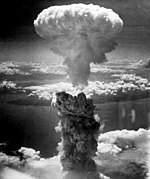Laboratorium Metalurgi
| File:Eckhart Hall.jpg
| |
| Didirikan | Februari 1943 |
|---|---|
| Tipe penelitian | terklasifikasi |
| Dana | $30.69 juta (1943–1946) |
| Bidang penelitian | Kimia dan metalurgi plutonium, rancangan reaktor nuklir |
| Direktur | Richard L. Doan Samuel K. Allison Joyce C. Stearns Farrington Daniels |
| Staf | 2,008 pada 1 Juli 1944 |
| Lokasi | Chicago, Illinois, Amerika Serikat |
| Agen operator | Universitas Chicago |
| Pemenang Nobel | Enrico Fermi James Franck Glenn Seaborg Eugene Wigner |
Laboratorium Metalurgi (bahasa Inggris: Metallurgical Laboratory; disingkat sebagai Met Lab) adalah sebuah laboratorium ilmiah di Universitas Chicago yang didirikan pada Februari 1942 untuk mempelajari dan menggunakan unsur kimia plutonium terbaru. Laboratorium tersebut meneliti kimia dan metalurgi plutonium, merancang reaktor nuklir pertama di dunia untuk memproduksi elemen tersebut, dan mengembangkan cara kimiawi untuk memisahkan unsur tersebut dari unsur-unsur lain. Pada Agustus 1942 bagian kimia laboratorium tersebut menjadi yang pertama untuk secara kimia memisahkan sampel plutonium yang dapat ditimbang, dan pada 2 Desember 1942, laboratorium tersebut menghasilkan reaksi rantai nuklir terkendalikan pertama, dalam reaktor Chicago Pile-1, yang dibangun dibawah tribun dari stadion sepak bola tua universitas tersebut, Stagg Field.
Laboratorium Metalurgi didirikan sebagai bagian dari Proyek Metalurgi, juga dikenal sebagai Proyek "Pile" atau "X-10", yang dikepalai oleh profesor Chicago Arthur H. Compton, seorang penerima Hadiah Nobel.
Asal-usul
[sunting | sunting sumber]Penemuan fisi nuklir dalam uranium oleh kimiawan Jerman Otto Hahn dan Fritz Strassmann pada Desember 1938, dan penjelasan teoretisnya (dan penamaan) oleh Lise Meitner dan Otto Frisch segera setelahnya,[1] membuka kemungkinan bahwa neutron yang dihasilkan oleh fisi dapat menciptakan reaksi rantai nuklir terkendalikan. Di Universitas Columbia, Enrico Fermi dan Leo Szilard mulai mengeksplorasi bagaimana hal tersebut dapat terjadi.[2]
Catatan
[sunting | sunting sumber]- ^ Rhodes 1986, hlm. 256–263.
- ^ Jones 1985, hlm. 8–10.
Referensi
[sunting | sunting sumber]- Anderson, Herbert L. (1975). "Assisting Fermi". Dalam Wilson, Jane. All In Our Time: The Reminiscences of Twelve Nuclear Pioneers. Chicago, Illinois: Bulletin of the Atomic Scientists. hlm. 66–104. OCLC 1982052.
- Compton, Arthur (1956). Atomic Quest. New York, New York: Oxford University Press. OCLC 173307.
- Groves, Leslie (1962). Now It Can Be Told: The Story of the Manhattan Project. New York, New York: Harper. ISBN 978-0-306-70738-4. OCLC 537684.
- Hacker, Barton C. (1987). The Dragon's Tail: Radiation Safety in the Manhattan Project, 1942–1946
 . Berkeley, California: University of California Press. ISBN 978-0-520-05852-1. OCLC 13794117.
. Berkeley, California: University of California Press. ISBN 978-0-520-05852-1. OCLC 13794117. - Hansen, Chuck (1995). Volume I: The Development of US Nuclear Weapons. Swords of Armageddon: US Nuclear Weapons Development since 1945. Sunnyvale, California: Chukelea Publications. ISBN 978-0-9791915-1-0. OCLC 231585284.
- Hewlett, Richard G.; Anderson, Oscar E. (1962). "The New World, 1939–1946" (PDF). Physics Today. 15 (12): 62. Bibcode:1962PhT....15l..62H. doi:10.1063/1.3057919. ISBN 978-0-520-07186-5. OCLC 637004643. Diakses tanggal 26 March 2013.
- Holl, Jack M.; Hewlett, Richard G.; Harris, Ruth R. (1997). Argonne National Laboratory, 1946–96. Urbana, Illinois: University of Illinois Press. ISBN 978-0-252-02341-5.
- Jones, Vincent (1985). Manhattan: The Army and the Atomic Bomb (PDF). Washington, D.C.: United States Army Center of Military History. OCLC 10913875. Diarsipkan dari versi asli (PDF) tanggal 2014-10-07. Diakses tanggal 25 August 2013.
- Manhattan District (1947a). Manhattan District History, Book IV – Pile Project X-10, Volume 1 – General Features (PDF). Washington, D.C.: Manhattan District.
- Manhattan District (1947b). Manhattan District History, Book IV – Pile Project X-10, Volume 2 – Research, Part 1 – Metallurgical Laboratory (PDF). Washington, D.C.: Manhattan District.
- Rhodes, Richard (1986). The Making of the Atomic Bomb. New York, New York: Simon & Schuster. ISBN 978-0-671-44133-3. OCLC 883475036.
- Salvetti, Carlo (2001). "The Birth of Nuclear Energy: Fermi's Pile". Dalam Bernardini, C.; Bonolis, Luisa. Enrico Fermi: His Work and Legacy. Bologna, Italy: Società Italiana di Fisica: Springer. hlm. 177–203. ISBN 978-88-7438-015-2. OCLC 56686431.
- Smyth, Henry DeWolf (1945). Atomic Energy for Military Purposes; the Official Report on the Development of the Atomic Bomb under the Auspices of the United States Government, 1940–1945. Princeton, New Jersey: Princeton University Press. ISBN 978-0-8047-1722-9. OCLC 265919046.
- Szanton, Andrew (1992). The Recollections of Eugene P. Wigner. New York, New York: Plenum. ISBN 978-0-306-44326-8. OCLC 612245667.
- Waltham, Chris (20 June 2002). An Early History of Heavy Water. Vancouver, British Columbia: Department of Physics and Astronomy, University of British Columbia. hlm. physics/0206076. arXiv:physics/0206076
 . Bibcode:2002physics...6076W.
. Bibcode:2002physics...6076W. - Wattenberg, Albert (1975). "Present at Creation". Dalam Wilson, Jane. All In Our Time: The Reminiscences of Twelve Nuclear Pioneers. Chicago, Illinois: Bulletin of the Atomic Scientists. hlm. 105–123. OCLC 1982052.
- Weinberg, Alvin (1994). "The First Nuclear Era: The Life and Times of a Technological Fixer". Physics Today. 48 (10): 63–64. Bibcode:1995PhT....48j..63W. doi:10.1063/1.2808209. ISBN 978-1-56396-358-2. OCLC 925205784.
Pranala luar
[sunting | sunting sumber]- Manhattan Project Signature Facilities
- Video of west stands of Stagg Field, Institute for the Study of Metals (Metallurgical Laboratory), Enrico Fermi, and an active experiment using CP-1

